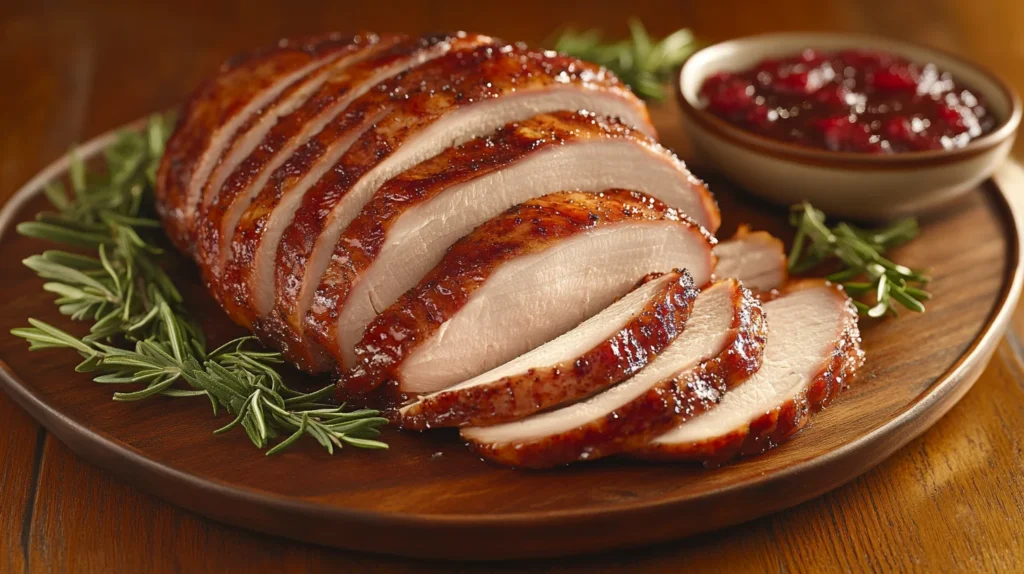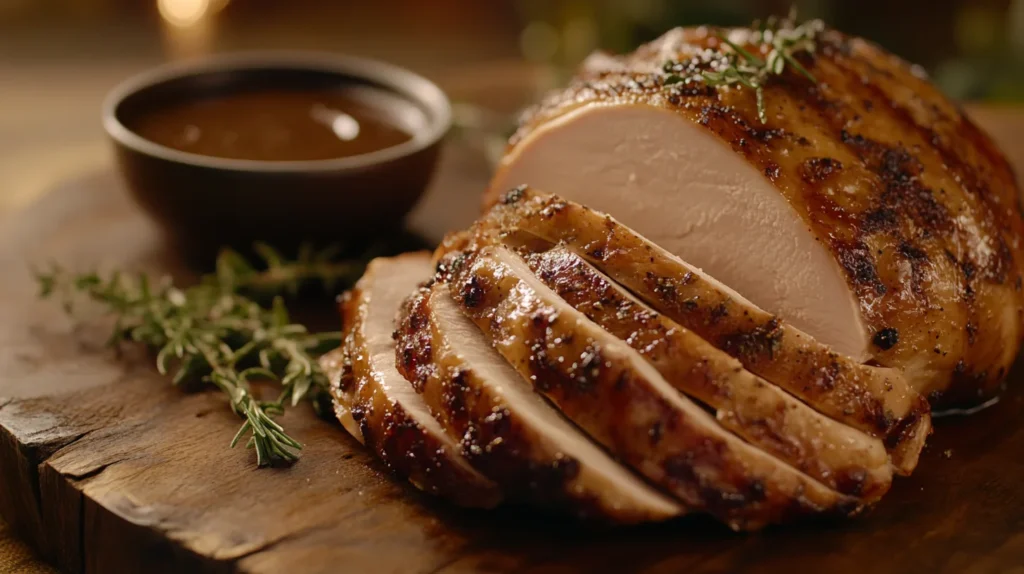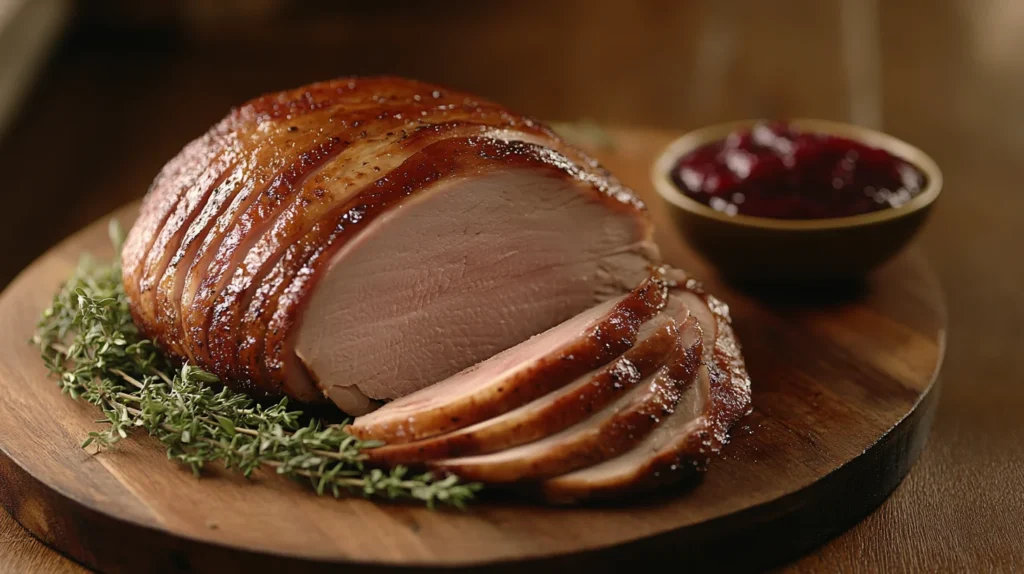Smoked Turkey Breast: The Ultimate Recipes Guide
Smoked Turkey Breast has become a beloved dish among many food enthusiasts and home cooks alike. Its smoky flavor and tender texture make it a centerpiece worth celebrating during festive gatherings or casual family dinners. In this guide, we will explore everything you need to know about making the perfect smoked turkey breast, from selecting the right turkey to advanced smoking techniques.
Introduction to Smoked Turkey Breast
The allure of smoked turkey breast cannot be overstated—it is not just a meal but an experience that elevates any occasion. The process of smoking adds layers of flavor that are both rich and complex. This culinary art form has its roots in ancient cooking methods, where people would smoke meats as a means of preservation, but today, it’s celebrated for the delightful taste and tenderness it brings to dishes.
Understanding the importance of smoking as a cooking technique requires an appreciation for its history. Smoking dates back thousands of years and has been practiced in various cultures around the world. From Native American communities that smoked fish and game to modern-day barbecue enthusiasts, the technique has evolved but remains deeply rooted in tradition. It symbolizes communal gatherings, celebrations, and a deep connection to food that nourishes both body and spirit.
As we delve deeper into the world of smoked turkey breast, we’ll discover how to recreate this exceptional dish at home, ensuring that each bite is infused with passion and flavor.
Choosing the Right Turkey
Selecting the right turkey breast is the first step towards crafting an unforgettable smoked turkey breast. There are several factors to consider when making your choice, as the quality and type of turkey can significantly impact the final result.
Factors to Consider When Selecting a Turkey Breast
When choosing a turkey breast, freshness is paramount. Fresh options often have superior flavor and texture compared to frozen varieties. If you go for frozen turkey, ensure that it has been properly thawed to maintain its quality. Check for a firm texture and avoid any that appear discolored or have an off-odor.
Another consideration is the size of the turkey breast; ideally, you want one that fits comfortably in your smoker while allowing room for even heat distribution. A large turkey breast may take longer to cook, while smaller ones will require less time. Depending on the number of guests you plan to serve, choose accordingly.
Types of Turkey: Fresh vs Frozen, Heritage vs Conventional
Fresh turkeys are typically more flavorful than their frozen counterparts due to minimal processing. However, high-quality frozen turkeys can also yield great results if handled and cooked correctly.
Heritage breeds are becoming increasingly popular among chefs and food enthusiasts. These birds are raised with care and allowed to roam freely, resulting in richer meat with distinct flavors. Conventional breeds, on the other hand, are commonly found in supermarkets and may be more economical. Ultimately, the choice between heritage and conventional turkey comes down to personal preference and budget.
Optimal Size for Smoking
For an ideal smoked turkey breast, look for a piece weighing between 5 to 8 pounds. This size strikes a balance between being manageable for home smokers and yielding enough portions for a gathering. Larger breasts can be more challenging to cook evenly, leading to potential issues with dryness or unevenly smoked flavors.
By taking these considerations into account, you can select the perfect turkey breast to embark on your smoking journey.

Preparing the Turkey Breast
Preparation plays a crucial role in achieving a flavorful and juicy smoked turkey breast. This stage involves thawing, cleaning, and brining the turkey breast—each step designed to enhance the overall taste and texture.
Thawing Techniques for Frozen Turkey
If you’ve opted for a frozen turkey breast, proper thawing is essential. The safest method is to place the turkey in the refrigerator for several days prior to smoking. This slow thaw allows the turkey to maintain its moisture and ensures even cooking.
Alternatively, if you’re short on time, submerging the sealed turkey breast in cold water can expedite the thawing process. Just remember to change the water every 30 minutes to keep it cold. Avoid thawing turkey at room temperature, as this can lead to bacterial growth.
Cleaning and Trimming the Turkey Breast
Once thawed, it’s time to clean and trim the turkey breast. Begin by rinsing it under cold water and patting it dry with paper towels. Trim away any excess fat or connective tissue, as this can contribute to an unpleasant texture once smoked.
Also, inspect the cavity of the turkey breast for any leftover giblets or packaging materials. Removing anything unnecessary not only improves the presentation but also allows for better seasoning penetration.
Importance of Brining and Various Brine Recipes
Brining is a critical step in preparing your turkey breast, as it helps infuse moisture and flavor. By soaking the turkey in a saltwater solution, you create a juicy and flavorful end product.
There are numerous brine recipes to try, ranging from simple to complex. A basic brine consists of water, salt, and sugar, but you can elevate it by adding herbs, spices, garlic, or even citrus fruits.
For example, a herbal brine with rosemary and thyme can impart a delightful fragrance to the turkey. Alternatively, a cider brine made with apple cider vinegar adds a pleasant tanginess that complements the smoky flavor beautifully.
Essential Equipment for Smoking
To successfully smoke a turkey breast, having the right equipment is crucial. Whether you’re a seasoned pro or a novice, understanding the different types of smokers and tools can help streamline the process and ensure delicious results.
Overview of Different Types of Smokers
There are several types of smokers available, each offering unique advantages and challenges. Electric smokers are user-friendly and provide consistent temperatures, making them ideal for beginners. They require minimal monitoring and allow for hands-off cooking.
Charcoal smokers, on the other hand, require more attention but offer a traditional smoky flavor that many enthusiasts cherish. They involve more skill in terms of temperature management, requiring you to monitor the charcoal and airflow constantly.
Pellet smokers combine the best of both worlds, utilizing wood pellets for fuel while providing the ease of electric smokers. They deliver a reliable smoke and are excellent for those who want versatility in their cooking.
Recommended Tools
In addition to the smoker itself, there are essential tools that will enhance your smoking experience:
- Meat Thermometer: An accurate meat thermometer is vital for ensuring that the turkey reaches safe internal temperatures while retaining juiciness.
- Wood Chips: Different wood chips offer varying flavors—select according to your preference. Hickory provides a bold flavor, while fruit woods like apple or cherry add a sweeter nuance.
- Smoker Box or Tray: If using a gas or electric grill, a smoker box can introduce smoke flavor effectively.
Safety Considerations for Outdoor Smoking
Safety should always come first when smoking outdoors. Ensure that your smoker is placed on a stable surface away from flammable materials and in a well-ventilated area. Always monitor the smoker to prevent flare-ups and be cautious of hot surfaces.
Additionally, familiarize yourself with safe food handling practices to avoid contamination and ensure your turkey breast is cooked to perfection.
Selecting Wood for Smoking
Choosing the right wood for smoking significantly influences the flavor profile of your smoked turkey breast. Different woods lend distinct characteristics to the meat, and knowing how to pair them can elevate your dish remarkably.
Different Types of Wood and Their Flavor Profiles
Hickory is one of the most popular choices for smoking turkey. It imparts a strong, hearty flavor that pairs well with the richness of the meat. However, it’s essential to use hickory in moderation; too much can overwhelm the turkey.
Fruitwoods like apple and cherry provide a milder, sweeter smoke. Applewood is particularly favored for poultry as it enhances the natural sweetness of the turkey without overpowering it.
Mesquite is another option, known for its strong flavor. Use it sparingly, as its intensity can overshadow the delicate turkey breast.
How Wood Choice Affects the Final Taste
The choice of wood doesn’t merely affect aroma; it can alter the taste experience entirely. For instance, combining different woods can create a balanced flavor—mixing hickory with applewood can yield a delicious complexity that tantalizes your palate.
Consider experimenting with combinations of flavored wood and adjusting based on the profiles you enjoy. Each smoking session offers a chance to refine and discover new tastes.
Tips for Soaking and Preparing Wood Chips
Soaking wood chips in water for at least 30 minutes before use can help produce more smoke and prolong the burn time. However, if you prefer a quicker burst of intense smoke, using dry chips can achieve that effect.
For best results, add soaked wood chips directly onto hot coals or in the smoker box to create a steady stream of smoke throughout the cooking process.

Seasoning and Marinades
Seasoning and marinating your turkey breast adds depth to the already enticing flavors of smoked turkey. From spice blends to marinades, a variety of options exist to suit individual preferences.
Popular Seasoning Blends for Smoked Turkey Breast
Creating a signature seasoning blend allows you to personalize the flavor profile of your smoked turkey breast. Common ingredients include:
- Salt and Pepper: The simplest yet classic combination.
- Paprika and Garlic Powder: Adds warmth and robust flavor.
- Herbs de Provence: A lovely mix of dried herbs that brightens the dish.
Feel free to play around with proportions until you find the blend that resonates with your taste buds.
Recipes for Dry Rubs and Marinades
A dry rub is an excellent way to season your turkey breast before smoking. A basic recipe might include brown sugar, paprika, garlic powder, onion powder, and salt. Rub the mixture generously over the turkey, ensuring even coverage.
For those preferring marinades, consider olive oil, vinegar, and fresh herbs. A citrus marinade can also do wonders, as the acidity tenderizes the meat, supplying a zesty kick.
Timing and Methods for Applying Seasonings
Timing matters when applying seasonings. For dry rubs, apply at least an hour before smoking—or even overnight—to allow the flavors to penetrate the meat. If using a marinade, aim for a few hours or overnight for optimal flavor infusion.
For added depth, consider injecting flavored brines directly into the turkey breast. This technique ensures that every bite is packed with flavor, making for a truly remarkable dining experience.
Smoking Process Step-by-Step
Now that you have the turkey prepared and seasoned, it’s time to dive into the smoking process. Understanding each step will help ensure success and satisfaction.
Preheating the Smoker: Optimal Temperature Settings
Before placing your turkey in the smoker, preheat it to the desired temperature. Typically, smoking turkey is done at low temperatures, around 225°F to 250°F. This allows for a gentle cooking process, enhancing tenderness while developing flavor.
Use a chimney starter for charcoal smokers, ensuring the coals are ready before introducing your turkey. For electric or pellet smokers, follow the manufacturer’s instructions to achieve a stable cooking temperature.
Placing the Turkey in the Smoker: Best Practices
When placing the turkey in the smoker, position it bone-side down. This positioning helps protect the meat from drying out and facilitates even cooking. If using a rack, elevate the turkey to allow smoke circulation around the meat.
Consider adding a water pan within the smoker to maintain humidity levels, which encourages a moist outcome.
Monitoring Internal Temperatures: Safe Cooking Guidelines
Using a reliable meat thermometer is essential to monitor the internal temperature of your turkey. The USDA recommends an internal temperature of 165°F for turkey to be considered safe for consumption. Insert the thermometer into the thickest part of the breast, avoiding contact with bones to ensure accuracy.
Keep an eye on the temperature throughout the smoking process, and adjust airflow or wood supply as needed. Be patient; good things take time, and smoking is no exception!
Cooking Times and Techniques
The cooking time for a smoked turkey breast varies depending on its weight and thickness. Understanding these variables will help you plan accordingly and achieve the best results.
General Cooking Times Based on Weight
As a general rule, plan for approximately 30 minutes of smoking per pound when cooking at 225°F to 250°F. For instance, a 6-pound turkey breast may require around 3 to 4 hours of smoking time.
Always refer to visual cues—the skin should turn golden brown, and juices should run clear when fully cooked.
Different Smoking Methods: Low and Slow vs Hot Smoking
While low and slow is the traditional approach, hot smoking is an alternative that yields quicker results. Hot smoking occurs at temperatures above 300°F, reducing cooking time but requiring careful monitoring to prevent drying out the meat.
Each method produces unique flavor profiles and textures, so feel free to experiment with both to find your preference.
Adjusting for Thicker Breasts or Uneven Shapes
If your turkey breast has an uneven shape or thicker areas, it may require adjustments in cooking time and placement. Consider rotating the turkey halfway through cooking to ensure even exposure to smoke and heat. Using a spatchcocking technique can also facilitate even cooking by flattening the bird.

Troubleshooting Common Issues
Even experienced cooks can encounter challenges when smoking turkey. Knowing how to troubleshoot common issues will empower you to handle any situation effectively.
Addressing Undercooked or Overcooked Turkey
If you find that your turkey is undercooked, simply return it to the smoker until it reaches the appropriate internal temperature. Always check multiple areas to ensure even cooking.
Conversely, if your turkey is overcooked, cover it loosely with aluminum foil after removing it from the smoker. This can help retain moisture and improve tenderness.
Managing Uneven Smoking and Flavor Distribution
Uneven smoking can result from improper placement in the smoker or insufficient wood. To combat this, rotate the turkey during smoking and reposition wood chips evenly throughout the coal bed.
Using a two-zone smoking strategy can also help, allowing for indirect heat and more controlled cooking.
Dealing with Moisture Loss and Dried-Out Meat
If you’re concerned about moisture loss, incorporating a water pan into the smoker can help maintain humidity levels. Additionally, applying a glaze or mop sauce during the smoking process can add moisture and flavor.
After smoking, rest the turkey for at least 15 to 20 minutes before slicing. This resting time redistributes the juices, preventing them from escaping upon cutting.
Serving Suggestions
Having expertly prepared smoked turkey breast opens the door to a world of serving possibilities. Pairing your dish with complementary side dishes can elevate your dining experience further.
Ideas for Side Dishes That Pair Well with Smoked Turkey Breast
Classic sides like mashed potatoes, stuffing, and green bean casserole are always a hit. Consider adding roasted seasonal vegetables for a colorful presentation and a burst of flavor.
For a refreshing contrast, a crisp salad with citrus vinaigrette can balance the richness of the turkey. Furthermore, cranberry sauce provides a sweet-tart element that beautifully enhances the overall meal.
Presentation Tips and Garnishing Ideas
Presentation is key when it comes to serving smoked turkey breast. Slicing the turkey against the grain reveals tender pieces and makes it visually appealing.
Garnish with fresh herbs like parsley or rosemary and serve on a rustic wooden board for a charming, farmhouse-style display. Adding seasonal fruits like pomegranate seeds or cranberries can also bring vibrant color to your plate.
Using Leftovers Creatively
One of the joys of smoking turkey is the leftovers! Consider transforming extra turkey into delightful sandwiches with crusty bread, lettuce, and your favorite sauces.
Turkey salad or wraps offer a lighter option, while hearty soups and stews can utilize the remaining meat and bones for a comforting meal.
Storing Smoked Turkey Breast
Proper storage ensures that your smoked turkey breast remains delicious even after the initial feast is over. Implementing good practices safeguards the flavors and textures you worked hard to achieve.
Best Practices for Cooling and Storing Leftovers
After enjoying your smoked turkey breast, allow any leftovers to cool at room temperature for no more than 2 hours. Once cooled, carve the turkey into slices for easier storage and portion control.
Store in airtight containers or wrap tightly in plastic wrap to prevent moisture loss and protect the flavor.
Freezing Options and Defrosting Tips
If you anticipate more leftovers than you can consume in a few days, freezing is a viable option. Properly wrapped turkey can last up to six months in the freezer.
When it comes time to enjoy your frozen turkey, transfer it to the refrigerator for gradual thawing. Avoid microwave defrosting, as it can unevenly heat the meat and compromise texture.
Duration of Freshness When Stored Properly
Generally speaking, smoked turkey breast will remain fresh in the refrigerator for 3-4 days if stored correctly. If you notice any signs of spoilage (such as foul odor or discoloration), err on the side of caution and discard it.
Frequently Asked Questions (FAQs)
How long does it take to smoke a turkey breast?
The time it takes to smoke a turkey breast typically ranges from 4 to 5 hours at 225°F. However, smoking times can vary depending on factors such as the size of the turkey breast, the exact temperature of your smoker, and whether it is bone-in or boneless. For instance, a 6-pound bone-in turkey breast may take closer to 5 hours, while a boneless breast could take less time. It’s crucial to monitor the internal temperature of the turkey rather than relying solely on time; aim for an internal temperature of 165°F for perfectly cooked turkey.
How do you keep smoked turkey breast from drying out?
To keep your smoked turkey breast juicy and moist, it’s essential to manage the smoking environment properly. Using a water pan in the smoker helps maintain humidity, preventing the meat from drying out. Basting periodically with your favorite marinade or turkey juices can also add moisture. Additionally, ensure that the smoker temperature is steady, as fluctuations can cause the turkey to dry out. Resting the turkey after smoking allows the juices to redistribute, keeping the meat moist when it’s carved.
Should I brine my turkey breast before smoking it?
Yes, brining is highly recommended when smoking a turkey breast. Brining enhances flavor and helps the turkey retain moisture during the smoking process. You can use either a wet brine (saltwater solution) or a dry brine (salt and spices rubbed onto the skin). Brining overnight ensures the turkey absorbs the flavors deeply and remains juicy after hours of smoking.
Is it better to smoke a turkey at 225 or 250?
Both 225°F and 250°F are suitable smoking temperatures for turkey breast. Smoking at 225°F results in a slower cooking process, which allows the smoke flavor to penetrate the meat more deeply, leading to a more tender and flavorful turkey. On the other hand, 250°F cooks the turkey slightly faster while still producing good results, though the turkey may have a slightly less intense smoky flavor.
Conclusion
The appeal of smoked turkey breast lies not only in its rich flavor and succulent texture but also in the memories created around the dining table. With the right preparation, equipment, and techniques, anyone can master the art of smoking turkey, making it a wonderful addition to any culinary repertoire.
Take the time to experiment with different flavors, methods, and presentations, and don’t hesitate to share your creations with loved ones. Let the smoky aroma fill your kitchen and the taste of perfectly cooked turkey delight your senses. Here’s to many delightful meals featuring this timeless dish!
For readers looking for more detailed, step-by-step instructions on smoking a turkey breast, this guide provides comprehensive tips to help you achieve the perfect smoked turkey every time.
If you’re looking for more delicious dessert recipes, check out our Eggnog Cheesecake Recipe
Print
Smoked Turkey Breast: The Ultimate Recipes Guide
- Total Time: 3 hours 15 minutes
- Yield: 6-8 servings
Description
Smoked turkey breast is a flavorful and juicy centerpiece, perfect for family dinners or special occasions. This recipe combines a savory spice rub with the rich, smoky flavor that brings out the best in turkey, creating a tender and unforgettable dish.
Ingredients
- Turkey breast (bone-in or boneless): 4-5 lbs
- Olive oil: 2 tbsp
- Paprika: 1 tbsp
- Garlic powder: 2 tsp
- Onion powder: 2 tsp
- Dried thyme: 1 tsp
- Black pepper: 1 tsp
- Kosher salt: 2 tsp
- Brown sugar: 1 tbsp (optional for a hint of sweetness)
- Wood chips (hickory, apple, or cherry): For smoking
Instructions
-
Prepare the Turkey Breast:
- Rinse the turkey breast and pat it dry with paper towels.
- Rub olive oil all over the turkey breast to help the seasoning stick.
-
Season:
- Mix paprika, garlic powder, onion powder, thyme, black pepper, salt, and brown sugar in a bowl.
- Generously rub the spice mixture all over the turkey breast, including under the skin if possible.
-
Prepare the Smoker:
- Preheat your smoker to 225°F (107°C) and add your choice of wood chips.
-
Smoke the Turkey:
- Place the turkey breast directly on the smoker grate, skin side up.
- Smoke for 3-4 hours, or until the internal temperature reaches 160°F (71°C) in the thickest part of the breast.
-
Rest and Serve:
- Remove the turkey breast from the smoker and let it rest for 15-20 minutes (the internal temperature will rise to 165°F/74°C).
- Slice and serve warm with your favorite sides.
Notes
- Optional Brine: For extra juicy turkey, brine it for 12-24 hours before smoking. Use a simple brine of water, salt, sugar, and your favorite herbs.
- Wood Chip Tip: Apple or cherry wood gives a mild, sweet flavor, while hickory adds a stronger, smoky taste.
- Storage: Leftovers can be refrigerated for up to 4 days or frozen for up to 2 months.
- Prep Time: 15 minutes
- Cook Time: 3-4 hours
- Category: Main Dish
- Method: Smoking
- Cuisine: American
Nutrition
- Serving Size: 6 oz (approx.)
- Calories: 210
- Sugar: 1g
- Sodium: 480mg
- Fat: 7g
- Saturated Fat: 2g
- Unsaturated Fat: 5g
- Trans Fat: 0g
- Carbohydrates: 2g
- Fiber: 0g
- Protein: 34g
- Cholesterol: 85mg
Keywords: Smoked turkey breast, Thanksgiving turkey, smoked meat recipes, holiday main dish, turkey breast recipe

